
At its core, product design is about solutions. Naturally, designers are always looking for inspiration, or new supplies, to add to their toolkit or “solution-space”[1].
However, some designers have found a more organic tool, which has the added benefit of generations of evolved intelligence behind it: nature itself.
Biomimicry in product design is an approach which seeks solutions by emulating characteristics or strategies from nature. Whether it be fauna or flora, the Biomimicry institute explain that “the core idea is that nature has already solved many of the problems we are grappling with”.
Even the plastic, which we work with in our factories here each day, was invented to imitate the properties of the material known as ivory. Harvested in elephant trunks ivory was an unsustainable, unethical, and expensive material.
It was difficult to source, and the only material with the right qualities required to create popular components such as piano keys, handles, and (of particular importance at the time) billiard balls. In attempting to find a suitable replacement, and by using this natural substance as the design standard, the durable but lightweight material known today as plastic was born.
“…most of the problems and conflicts we face as humans have already been solved sustainably by animals. We need to study animal models, emulate their forms, processes, and strategies to design sustainable ways to solve human struggles.” – Claire Tang
Not only does nature provide some pleasing aesthetic shapes, but it also gives us hints to developing better materials, systems and technologies. Author Janine Benyus explains that “doing it nature’s way” has transformative potential, and categorises the application of this approach to nature as model, measure, and mentor[2].
Today, we discuss mature as model, specifically the imitation of form or function as found in the natural world, in our favourite examples of biomimicry in industrial design applications.
“Animals, plants, and microbes are the consummate engineers. After billions of years of research and development, failures are fossils, and what surrounds us is the secret to survival.” – Biomimicry Institute
1. LOTUS FLOWER – KEEPING IT CLEAN
First on our list is the beautiful lotus flower. Known for its ability to rise above dirty waters, the lotus is a metaphorical representation of resilience and purity in religious an spiritual spheres. Its form has been a source of inspiration across many design fields.
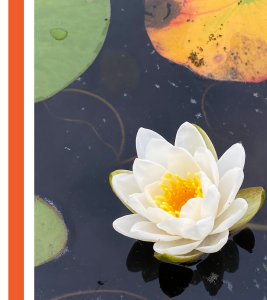 But as beautiful as it is, aesthetics may be the least interesting thing about this super-flower. It is not merely the form which sparks design inspiration; it has also motivated the development of materials which can replicate its physical properties and function. Scientists are fascinated with this flower “response to different atmospheres…and the way it provides itself with energy to survive”[3].
But as beautiful as it is, aesthetics may be the least interesting thing about this super-flower. It is not merely the form which sparks design inspiration; it has also motivated the development of materials which can replicate its physical properties and function. Scientists are fascinated with this flower “response to different atmospheres…and the way it provides itself with energy to survive”[3].
The Lotus flower has an uncanny self-cleaning ability, and a natural defence mechanism against fungus. It is also known for its superhydrophobicity: the nanostructures of the plant, micro-protrusions coated in waxy hydrophobic materials, help repel water and dirt. These qualities were successfully applied to technical applications and patented as the Lotus-Effect[4].
The subtle survivability and environmental resilience of this flower hints at the possibility of sustainable design solutions. Today we see the resulting innovations in new types of paints, substance-resistant window glass, self-cleaning solar panels, and recreational applications such as outdoor furniture or camping tents.
Some specific product examples include StoColor Lotusan self-cleaning paints for lower maintenance, and TresClean, a project for metal, antibacterial surfaces with no chemical treatments for medical applications. It was even inspired a textile fabric, made from what is coined the ‘Lotus Fibre’, which has self-cleaning and water repelling functions.[5]
“The characteristic of lotus to stay clean in the mud is not simply describing the biological phenomenon of nature, but also has a deeper significance. It refers that we should learn the self-cleaning function of lotus, no matter how dirty the world and how bad the environment…” – Xian Yuan Wei.
The Lotus flower has been monumentally impactful on us humans. Culturally, spiritually, environmentally, and technologically, it has helped us grow and bloom in ways we can’t be-leaf, particularly in the world of industrial design. The lotus reminds us that there are always seeds of potential for change, even in the most likely of places.
2. GECKO TOES – ADHESIVE ABILITIES
As stated by Natalie Angier, the beauty of the natural world lies in the details. Geckos are known for three key details which distinguish them from their lizard counterparts: their googly eyes, their long tongues, and their weird ability to walk up walls- or specifically, their sticky toes.
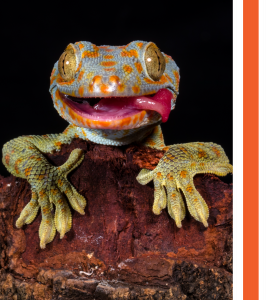 In actuality, their toes are soft and smooth to the touch. Instead of a glue or another tacky substance, Geckos have a series of ridges covered in fine, split hairs called ‘setae’[6]. These hairs allow for intermolecular forces, called Van der Waals forces, to provide adhesion; simply put, the stickiness is a result of a molecular level, distance-dependant electromagnetic attraction[7].
In actuality, their toes are soft and smooth to the touch. Instead of a glue or another tacky substance, Geckos have a series of ridges covered in fine, split hairs called ‘setae’[6]. These hairs allow for intermolecular forces, called Van der Waals forces, to provide adhesion; simply put, the stickiness is a result of a molecular level, distance-dependant electromagnetic attraction[7].
These impressive biomechanics make the gecko an excellent climber, but it also provides inspiration for scientists researching new adhesive materials for human use. Scientists are interested in their adhesive abilities, as well as their facility in detaching. From observing these little lizards, synthetic setae made from polymer etched with electrons has now been used to develop new products, such as ‘Gecko Tape’, a reusable tape which outperforms the common sticky tape.
It was also inspired researchers at Stanford University to create pads which allow humans to climb vertically, just like geckos, using microwedges: a solution to the struggle of upscaling the physics of a gecko’s foot[8].
The possibilities of future applications of this innovation are endless; for example, we may soon see advances in the manufacturing sector, with assembly line machinery benefiting from a highly flexible and versatile grip. Or perhaps it will shine brightest in the interior design field, allowing for increased facility and creativity in wall decorations.
Who knew there were so many possibilities hidden under a lizards’ foot!
3. OWL – SILENT FLIGHT
There’s no creature better known for its wisdom than the owl. Fittingly, the owl is also a source of innovative inspiration for designers in all fields. Researchers have been continuously fascinated by this mysterious creature, specifically with the form and function of its unique wings which have perfectly adapted to generate little to no noise during flight.
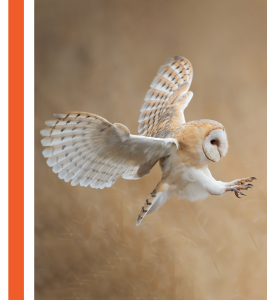 The owl is a remarkable silent predator. They have even been labelled as the quietest flier, both due to their low flying speeds, and their specially evolved, naturally inimitable feathers[15]. They are characterised by: comb-like leading edge feathers; a fringe formed by trailing edge feathers; and (most adorably) their fluff factor which helps to absorb noise[16]. Velvety feathers cover their wing’s upper surface, lower surface, and legs, allowing them to both flap and glide at under 2kHz[17].
The owl is a remarkable silent predator. They have even been labelled as the quietest flier, both due to their low flying speeds, and their specially evolved, naturally inimitable feathers[15]. They are characterised by: comb-like leading edge feathers; a fringe formed by trailing edge feathers; and (most adorably) their fluff factor which helps to absorb noise[16]. Velvety feathers cover their wing’s upper surface, lower surface, and legs, allowing them to both flap and glide at under 2kHz[17].
Thus, the owl inspires and motivates researchers, engineers and designers alike to find innovative applications in which to transfer these seasoned evolutionary techniques into new human technologies[18]. This has clear multi-industry potential. However, in the industrial design world, the owl has inspired quieter wind turbine blades, leading to new “serrated owl wing turbines” which have a 14.3 dB noise reduction[19].
It has also encouraged the development of quieter turbine jet engines, which aim to address ear damage caused by testing, take-off and landing[20]. Aerodynamic researchers are also interested in the owl, focusing on wing flexibility and potential increased performance in airplane applications[21].
“It would…be a mistake to ignore birds as a guide to possible future developments. One of the most interesting groups of birds is that which includes all the owls, for there is a possible connection between the manner in which their strikingly silent flight is achieved and the increasingly pressing problem of silencing airscrews.” – R. R. Graham, 2016
One of the earliest examples of biomimicry was in the study or birds: Leonardo da Vinci observed the anatomy of birds to create the first sketches of “flying machines”, and a few centuries later the Wright Brothers studied pigeons to eventually develop the first airplane[22]. It’s thus to no surprised that the owl has swooped into help us with modern innovations!
4. SHARK SCALES
There’s some-fin pretty special about our favourite underwater predator. The shark is not just a blockbuster icon with an epic theme song, but also a motivational source for innovation. Well known for their clean skin and stealthy swimming abilities, studying this killer fish has opened potential for applications in both the medical and engineering industry[23].
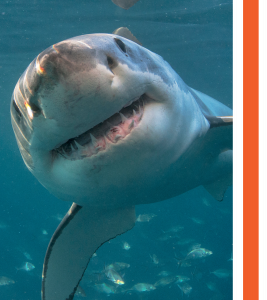 Shark skin is made up of small, tooth-like scales called ‘dermal denticles’, which are responsible for the sharks sleek movement and bio-fouling qualities; marine organisms are unable to stick to the sharks skin, providing a genius model for germ resistant surface material[24]. This has led to the development of Sharklet AF, a synthetic material which hinders the growth of diseases, germs and bacteria (which is also free from disinfectant, chemicals and toxins), effective for medical devices and equipment[25].
Shark skin is made up of small, tooth-like scales called ‘dermal denticles’, which are responsible for the sharks sleek movement and bio-fouling qualities; marine organisms are unable to stick to the sharks skin, providing a genius model for germ resistant surface material[24]. This has led to the development of Sharklet AF, a synthetic material which hinders the growth of diseases, germs and bacteria (which is also free from disinfectant, chemicals and toxins), effective for medical devices and equipment[25].
Sharks have also made a splash in the textiles industry with Sharkskin-inspired swimsuits, which replicates the denticles’ grooves sitting in alignment with the water flow. This same technique can also applied industrially for boats, seen in the Speedo Fastskin material[26]. The denticles are placed at the bottom of boats and have been seen to the most effective method for drag reducation[27]. Additionally, the sharks’ flexible scales can bristle up to 50 degrees with reversed flow. Biomimicking this feature can help control fluid flow, and consequently reduce burning bunker oil providing significantly more sustainable and effective results[28].
Sharks, and their special sandpaper skin, have offered some invaluable insights which have allowed for multi-industry innovation. For over an estimated 450 million years, hundreds of different shark species have ruled our oceans, lakes and rivers. They’ve been around longer than trees and dinosaurs; today, these old dogs are teaching us humans some new tricks, helping us pave new paths for innovation.
5. BUTTERFLY WINGS – SOLAR INNOVATION
Kjell B. Sandved once said: “nature’s message was always there and for us to see. It was written on the wings of butterflies”. It turns out, this quote can be applied more than metaphorically. Whilst butterfly wings are for their beauty, often imitated in artistic design projects, it also has innovative properties which have potential to change the face of solar power.
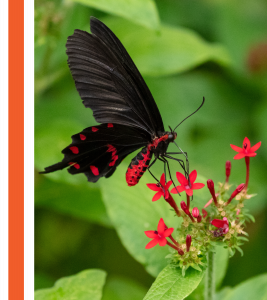 The Rose Butterfly, native to Southeast Asia, relies heavily on sunlight due to being cold blooded. For this reason, butterfly’s wings have evolved not just in its darker colour, but also in a unique microscopic structure which enhances light absorption rate. The wings are also made from small scales, covered in randomly spaced holes which help scatter the light over a wide spectral and angular range[9].
The Rose Butterfly, native to Southeast Asia, relies heavily on sunlight due to being cold blooded. For this reason, butterfly’s wings have evolved not just in its darker colour, but also in a unique microscopic structure which enhances light absorption rate. The wings are also made from small scales, covered in randomly spaced holes which help scatter the light over a wide spectral and angular range[9].
Studying the rose butterfly wing’s unique properties inspired scientists, or rather “bioinspired”, the development of solar cells[10]. Usually, solar panels are made from thick cells, positioned to get the most amount of sun as possible as it makes its daily round across the sky. Thinner developments which have been released are cheaper and lighter, but also less efficient[11].
These new cells have as large as a 200% increased absorption rate and are now being further developed to mimic the flexible curved surface of the wings which may also optimize performance. In imitating the spaced holes, the panels were able to harvest light twice as efficiently than before[12]. Researchers form the Energy & Environmental Science Journal have described this innovation as “the product of an intimate conversation between humanity and nature, as well as close cooperation between scientists from diverse fields”[13].
Butterflies have also inspired a research team at the Australian National University to develop tiny nanostructures used to effectively redirect light, an innovation with a wide range of possible applications[14].
This insect has proven itself worthy of inspection, whether for its elegant its pigments and patterns, or its structural form, which allows for unique functionalities of which we are still uncovering. If nothing else, the butterfly reminds us as designers that through great change, comes great beauty.
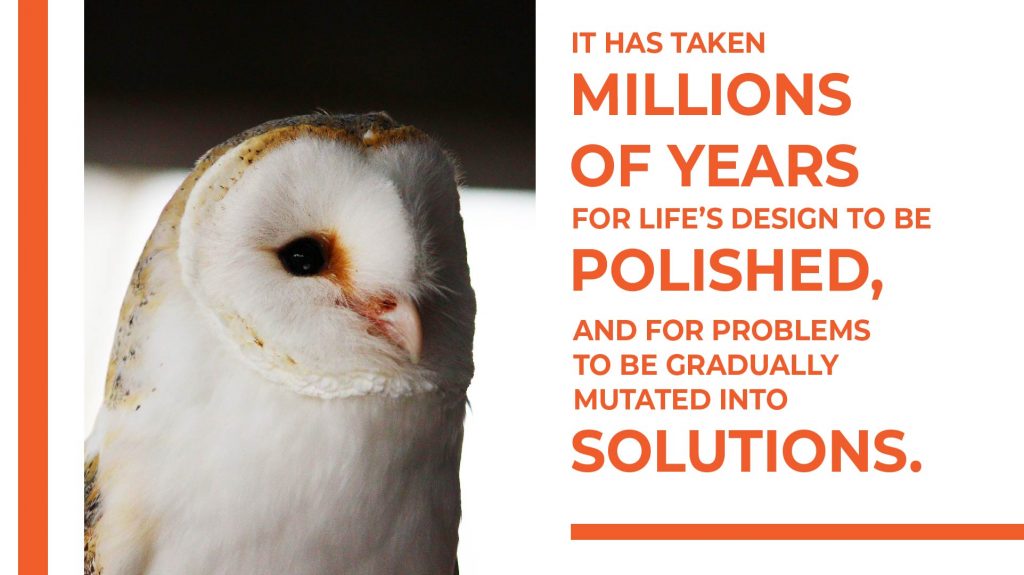
Humans have looked to nature for answers for eons. Not only is it beautiful, but it is also fascinatingly functional. Although we are often responsible for exploiting its riches, in return it only provides us with the inspiration to better our future[29].
In the world of industrial design, biomimicry us attractive due to its influence in industries from which we incorporate our knowledge, and have seen up close how effective it can be in finding solutions[30]. Yet despite this, Professor of biomimetics Julian Vincent claims only a 10% existing overlap between biology and technology, its large potential yet to be explored[31].
However, not everyone believes nature is the best solution. Some argue that evolution is not a recipe for perfection, but rather one of “just good enough”[32]; as designers, we don’t just want something to work, we want it to work better. Biomimicry in this perspective is thus presented as merely a supplement to the designer’s existing toolkit, suitable for sparking ideas, but not for direct transfer of data from animal to product.
“Biomimicry does not usually mean the direct transfer of an observation in nature to the development of a product, but rather the creative implementation of biological concepts into products…it should be regarded as a way to enlarge the designer’s solution-space.” N.L. Volstad
Either way, mimicking nature has always been part of the designer’s job. It has found solutions and ingenuity where humans, even assisted with computers and modern technologies, cannot[33]. Even computers have begun to take a design curve, becoming increasingly human-like in an attempt to replicate humans.
From scarecrows to Siri, we’ve always searched for solutions from life forms, even it’s ourselves. Because sometimes, nature just does it better.
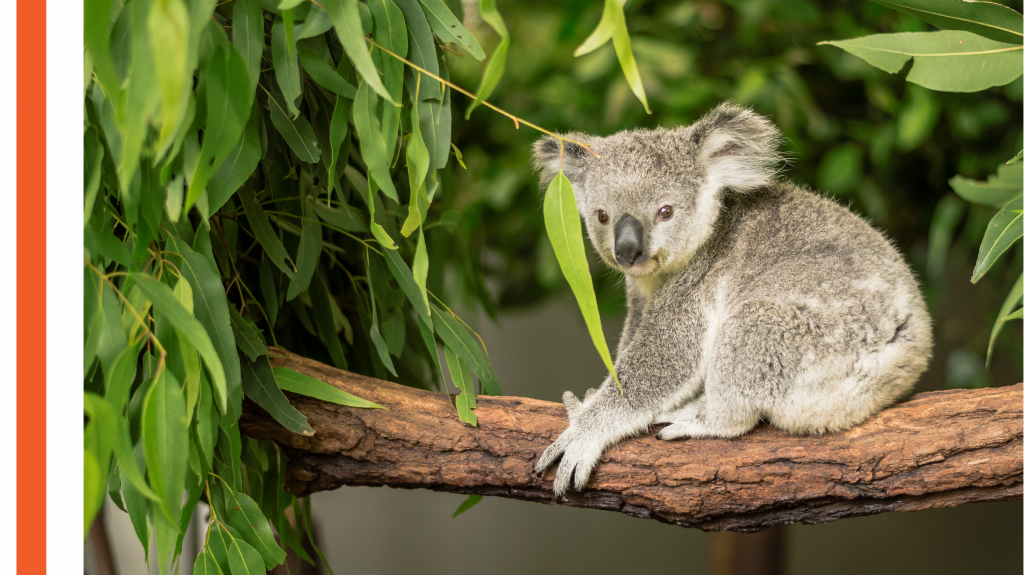
REFERENCES
[1] Volstad, N. L., & Boks, C. (2012). On the use of Biomimicry as a Useful Tool for the Industrial Designer. Sustainable Development, 20(3), 189–199. https://doi.org/10.1002/sd.1535
[2] A conversation with author Janine Benyus – Biomimicry 3.8. (2016). Biomimicry 3.8. https://biomimicry.net/the-buzz/resources/conversation-author-janine-benyus/
[3] The lotus flower: biomimicry solutions in the built environment Y. Nanaa & H. Taleb Sustainable Design of the Built Environment, British University in Dubai, UAE
[4] Spaeth, M., & Barthlott, W. (2008). Lotus-Effect®: Biomimetic Super-Hydrophobic Surfaces and their Application. Advances in Science and Technology, 60, 38–46. https://doi.org/10.4028/www.scientific.net/ast.60.38
[5] Wei, X. Y. (2014). The Reproduction of New Clothing Materials – Lotus Effect. Advanced Materials Research, 1055, 88–91. https://doi.org/10.4028/www.scientific.net/amr.1055.88
[6] K. Autumn, A. Dittmore, D. Santos, M. Spenko, M. Cutkosky; Frictional adhesion: a new angle on gecko attachment. J Exp Biol 15 September 2006; 209 (18): 3569–3579. doi: https://doi.org/10.1242/jeb.02486
[7] I.E. Dzyaloshinskii , E.M. Lifshitz & L.P. Pitaevskii (1961) The general theory of van der Waals forces, Advances in Physics, 10:38, 165-209, DOI: 10.1080/00018736100101281
[8] Hawkes Elliot W., Eason Eric V., Christensen David L. and Cutkosky Mark R. 2015Human climbing with efficiently scaled gecko-inspired dry adhesivesJ. R. Soc. Interface.122014067520140675
http://doi.org/10.1098/rsif.2014.0675
[9] Siddique, R. H., Donie, Y. J., Gomard, G., Yalamanchili, S., Merdzhanova, T., Lemmer, U., & Hölscher, H. (2017). Bioinspired phase-separated disordered nanostructures for thin photovoltaic absorbers. Science Advances, 3(10), e1700232. https://doi.org/10.1126/sciadv.1700232
[10] Senthil, R., & Yuvaraj, S. (2019). A comprehensive review on bioinspired solar photovoltaic cells. International Journal of Energy Research, 43(3), 1068-1081.
[11] Chen, A. (2017, October 19). Butterfly wings inspire a better way to absorb light in solar panels. The Verge. https://www.theverge.com/2017/10/19/16503258/butterfly-wings-engineering-solar-cell-energy-biomimicry
[12] Siddique, R. H., Donie, Y. J., Gomard, G., Yalamanchili, S., Merdzhanova, T., Lemmer, U., & Hölscher, H. (2017). Bioinspired phase-separated disordered nanostructures for thin photovoltaic absorbers. Science Advances, 3(10), e1700232. https://doi.org/10.1126/sciadv.1700232
[13] Lou, S., Guo, X., Fan, T., & Zhang, D. (2012). Butterflies: inspiration for solar cells and sunlight water-splitting catalysts. Energy & Environmental Science, 5(11), 9195. https://doi.org/10.1039/c2ee03595b
[14] Construction & Architecture News. (n.d.). Architecture & Design. Retrieved August 29, 2022, from https://www.architectureanddesign.com.au/news/butterfly-inspires-the-design-of-new-smart-solar-w#
[15] Geyer, T., Sarradj, E., & Fritzsche, C. (2014, October). Measuring owl flight noise. In INTER-NOISE and NOISE-CON Congress and Conference Proceedings (Vol. 249, No. 8, pp. 183-198). Institute of Noise Control Engineering.
[16] R. Boucetta, “Design, modelling and control of an owl-inspired unmanned vehicle,” 2020 17th International Multi-Conference on Systems, Signals & Devices (SSD), 2020, pp. 997-1002, doi: 10.1109/SSD49366.2020.9364138.
[17] Lilley, G. (1998). A study of the silent flight of the owl. 4th AIAA/CEAS Aeroacoustics Conference. https://doi.org/10.2514/6.1998-2340
[18] Wagner, H., Weger, M., Klaas, M., & Schröder, W. (2017). Features of owl wings that promote silent flight. Interface Focus, 7(1), 20160078. https://doi.org/10.1098/rsfs.2016.0078
[19] Wang, L., Liu, X., & Li, D. (2021). Noise reduction mechanism of airfoils with leading-edge serrations and surface ridges inspired by owl wings. Physics of Fluids, 33(1), 015123. https://doi.org/10.1063/5.0035544
[20] Premkumar, B., & Nandakumar, N. (2021). Implementing Biomimicric Owl Wing Pattern for Noise Reduction in Turbine Blade. Springer Proceedings in Materials, 175–182. https://doi.org/10.1007/978-981-15-8319-3_19
[21] Wagner, H., Weger, M., Klaas, M., & Schröder, W. (2017). Features of owl wings that promote silent flight. Interface Focus, 7(1), 20160078. https://doi.org/10.1098/rsfs.2016.0078
[22] Gaia. (2010). What is Biomimicry? Environment-Ecology.com. http://environment-ecology.com/biomimicry-bioneers/367-what-is-biomimicry.html
[23] Lee, M. (2014). Shark skin: taking a bite out of bacteria. In Remarkable natural material surfaces and their engineering potential (pp. 15-27). Springer, Cham.
[24] Lodson, J., & Jahromi, F. S. (2017). Sustainable Innovative Materials for Interior Architecture Using Biomimicry. Sustainable Structure and Materials, 1, 1-11.
[25] Chung, K. K., Schumacher, J. F., Sampson, E. M., Burne, R. A., Antonelli, P. J., & Brennan, A. B. (2007). Impact of engineered surface microtopography on biofilm formation of Staphylococcus aureus. Biointerphases, 2(2), 89–94. https://doi.org/10.1116/1.2751405
[26] Keriazes, K. A., & Chuang, J. L. Biomimicry of Sharkskin to Improve Hydrodynamics.
[27] Hampshire, U. of N., Technology, R. I. of, & Maine, U. of S. (2019, May 3). 8 Amazing Examples of Biomimicry. Treehugger. https://www.treehugger.com/amazing-examples-of-biomimicry-4869336
[28] Gamble, L., Lang, A., Bradshaw, M., & McVay, E. (2013, November). Surface Patterning: Controlling Fluid Flow Through Dolphin and Shark Skin Biomimicry. In APS Division of Fluid Dynamics Meeting Abstracts (pp. 1A-034).
[29] Frank E. Fish, Paul W. Weber, Mark M. Murray, Laurens E. Howle, The Tubercles on Humpback Whales’ Flippers: Application of Bio-Inspired Technology, Integrative and Comparative Biology, Volume 51, Issue 1, July 2011, Pages 203–213, https://doi.org/10.1093/icb/icr016
[30] Volstad, N. L., & Boks, C. (2012). On the use of Biomimicry as a Useful Tool for the Industrial Designer. Sustainable Development, 20(3), 189–199. https://doi.org/10.1002/sd.1535
[31] Volstad, N. L., & Boks, C. (2012). On the use of Biomimicry as a Useful Tool for the Industrial Designer. Sustainable Development, 20(3), 189–199. https://doi.org/10.1002/sd.1535
[32] Volstad, N. L., & Boks, C. (2012). On the use of Biomimicry as a Useful Tool for the Industrial Designer. Sustainable Development, 20(3), 189–199. https://doi.org/10.1002/sd.1535
[33] Boucetta, R. (2019). Design, modeling and control of an owl-inspired robot in a standing posture. 2019 International Conference on Signal, Control and Communication (SCC). https://doi.org/10.1109/scc47175.2019.9116102

